© Bank of England. These images are approved by the Bank of England for public use provided these conditions are satisfied.
£20 Series F
Date first issued: 13 March 2007
Date ceased to be legal tender: 30 September 2022
Colour: Multi-coloured (predominantly purple)
Size: 149mm x 80mm
Design: Bank of England
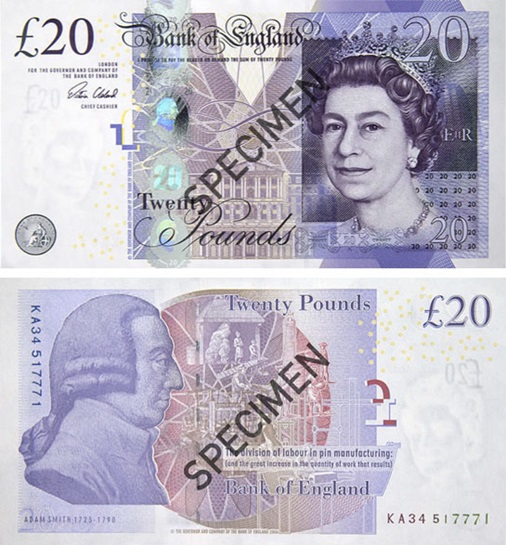
Front and back of note
£50 Series F
Date first issued: 2 November 2011
Date ceased to be legal tender: 30 September 2022
Colour: Multi-coloured (predominantly red)
Size: 156mm x 85mm
Design: Bank of England
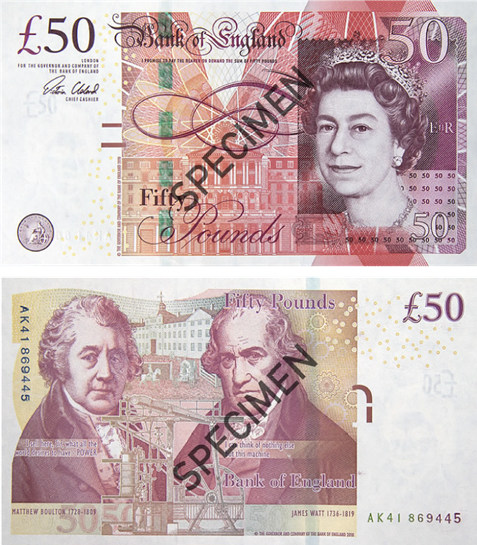
Front and back of note
£10 Series E (Variant)
Date first issued: 7 November 2000
Date ceased to be legal tender: 1 March 2018
Colour: Multi-coloured (predominantly orange-brown)
Size: 142mm x75mm
Design: Bank of England
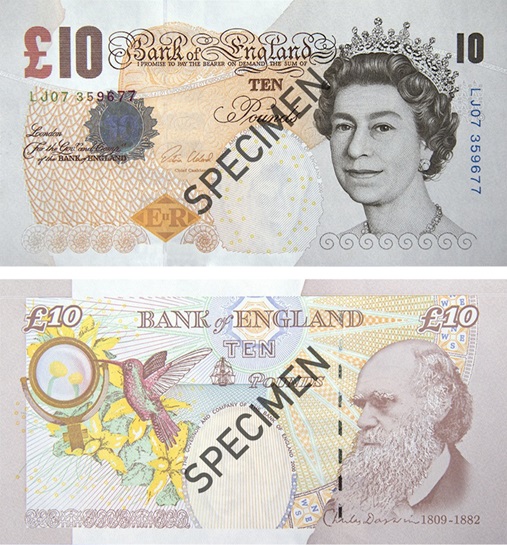
Front and back of note
£5 Series E (Variant)
Date first issued: 21 May 2002
Date ceased to be legal tender: 5 May 2017
Colour: Front green, back green
Size: 5 5/16" x 2 3/4" (135mm x 70mm)
Design: Andy Ward as Chief Designer and design work by Debbie Marriott
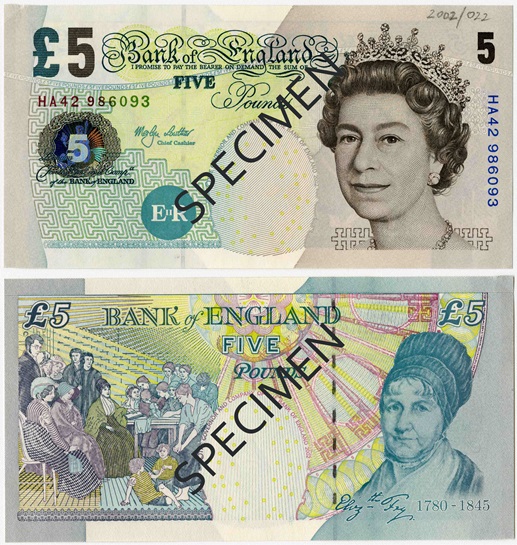
Front and back of note
£20 Series E (Variant)
Date first issued: 22 June 1999
Date ceased to be legal tender: 30 June 2010
Colour: Multicoloured (predominantly mauve-purple)
Size: 5 7/8" x 3 1/8" (149mm x 80mm)
Design: Roger Withington & Andrew Ward. Windowed thread on the back of the note. Additional security features: foil hologram, an ultra-violet feature and micro-lettering. Design work by Debbie Marriott
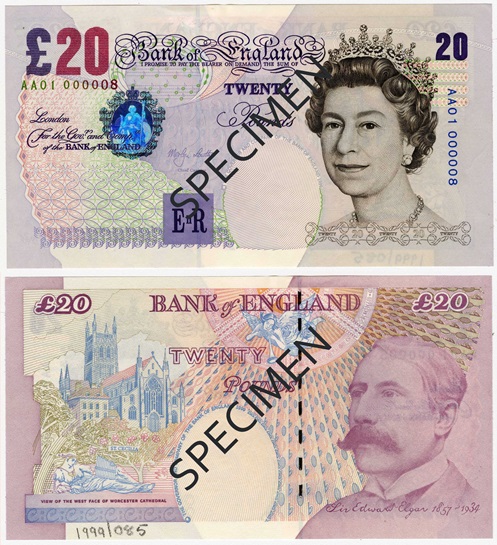
Front and back of note
£50 Series E
Date first issued: 20 April 1994
Date ceased to be legal tender: 30 April 2014
Colour: Multicoloured (predominantly red)
Size: 6 1/7" x 3 1/3" (156mm x 85mm)
Design: Roger Withington. Sir John Houblon portrayed on back. Windowed thread on the front of the note. Additional security features: foil patch.
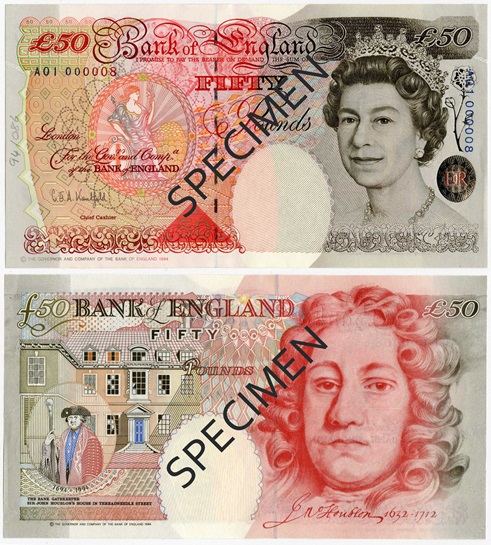
Front and back of note
£10 Series E (revised version)
Date first issued: 22 November 1993
Date ceased to be legal tender: 31 July 2003
Colour: Multicoloured (predominantly orange-brown)
Size: 5 9/16" x 2 15/16" (142mm x 75 mm)
Design: Roger Withington. Revised version issued: additional denomination symbol £10, black in colour, to replace crown feature in top-right corner of note (front); further denomination symbol £10, dark brown in colour, added to top-right corner of note near head of Charles Dickens (reverse).
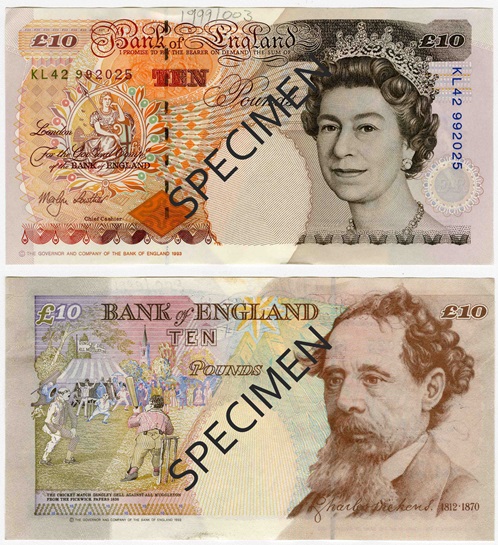
Front and back of note
£20 Series E (revised version)
Date first issued: 27 September 1993
Date ceased to be legal tender: 28 February 2001
Colour: Multicoloured (predominantly mauve-purple)
Size: 5 7/8" x 3 1/8" (149mm x 80mm)
Design: Roger Withington. Revised version issued: colour of denomination symbol £20 in top-left hand corner changed to darker purple and additional denomination symbol, black in colour, to replace crown feature in top-right corner (point); further denomination symbol £20, purple-grey in colour, added to top-right corner near head of Michael Faraday.
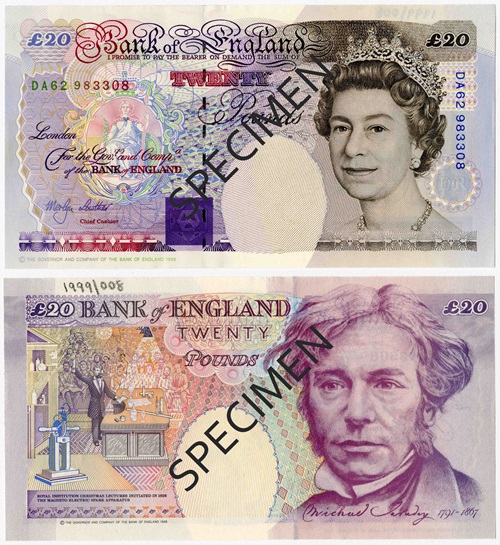
Front and back of note
£5 Series E (revised version)
Date first issued: 1 March 1993
Date ceased to be legal tender: 21 November 2003
Colour: Revised version issued - colour of denomination symbol "£5" in top-left corner changed to bolder dark blue/green (front) and stronger olive/drab colour (back)
Size: 5 5/16" x 2 3/4" (135mm x 70mm)
Design: Roger Withington
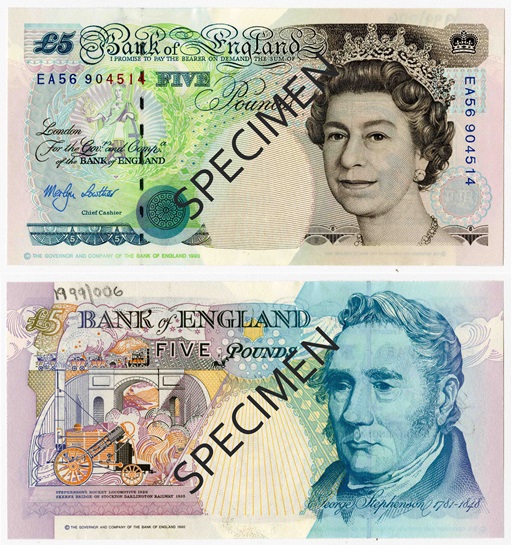
Front and back of note
£10 Series E
Date first issued: 29 April 1992
Date ceased to be legal tender: 31 July 2003
Colour: Multicoloured (predominantly orange-brown)
Size: 5 9/16" x 2 15/16" (142mm x 75 mm)
Design: Roger Withington. Charles Dickens portrayed on reverse; ‘windowed’ thread on reverse.
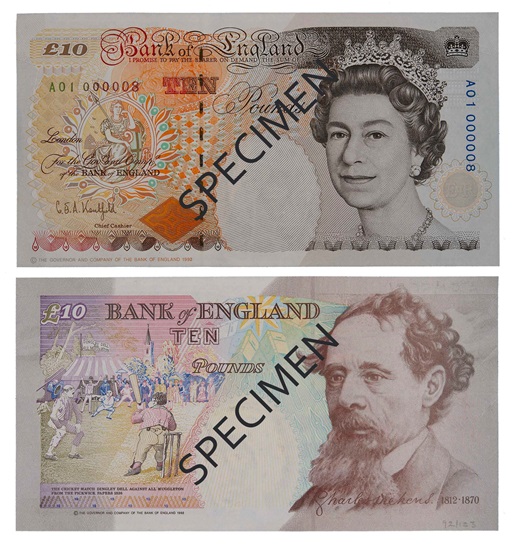
Front and back of note
£20 Series E
Date first issued: 5 June 1991
Date ceased to be legal tender: 28 February 2001
Colour: Multicoloured (predominantly mauve-purple)
Size: 5 7/8" x 3 1/8" (149mm x 80mm)
Design: Roger Withington. Michael Faraday portrayed on the reverse; 'windowed' thread.
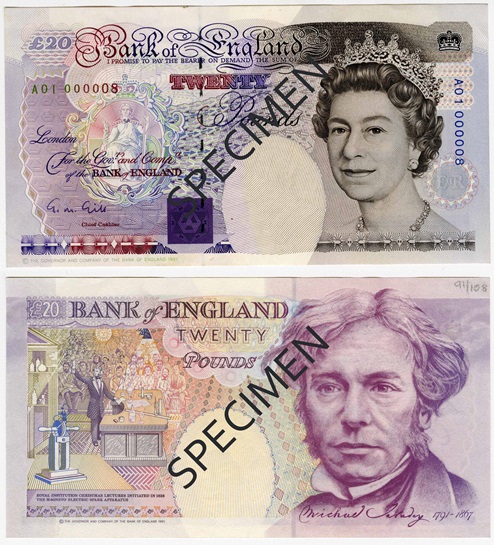
Front and back of note
£5 Series E
Date first issued: 7 June 1990
Date ceased to be legal tender: 21 November 2003
Colour: Multicoloured (predominantly turquoise-blue)
Size: 5 5/16" x 2 3/4" (135mm x 70mm)
Design: Roger Withington. Stephenson portrayed on reverse; 'windowed' thread.
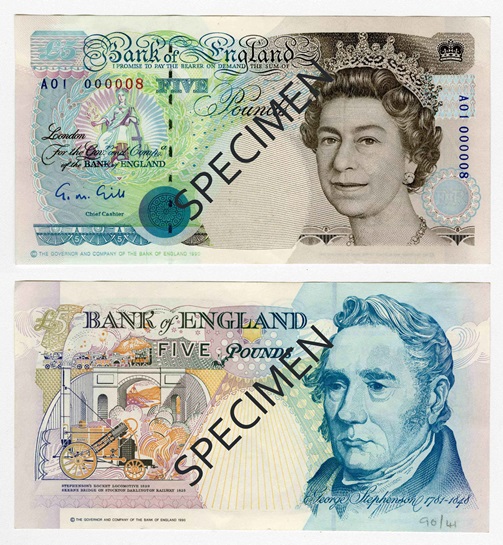
Front and back of note
£50 Series D
Date first issued: 20 March 1981
Date ceased to be legal tender: 20 September 1996
Colour: Predominantly brown
Size: 6 5/8" x 3 3/4" (169mm x 95mm)
Design: H N Eccleston and Roger Withington. Sir Christopher Wren portrayed on the reverse. New contoured thread used initially; 'windowed' security thread introduced on 21 July 1988.
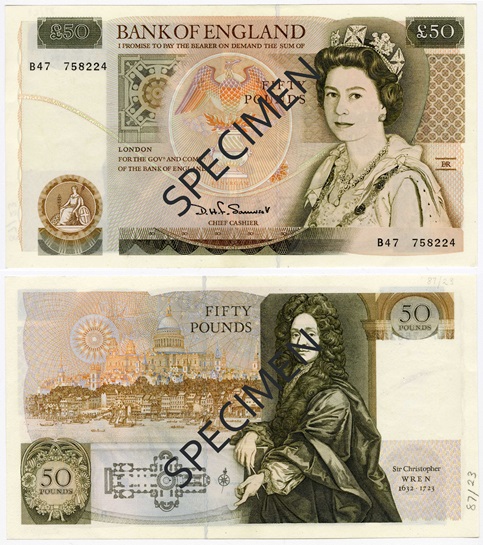
Front and back of note
£1 Series D (revised version)
Date first issued: 20 March 1981
Date ceased to be legal tender: 11 March 1988
Colour: Predominantly green
Size: 5 5/16" x 2 5/8" (135mm x 67mm)
Design: Harry Eccleston. Revised version issued with design and dimensions (as Series D) but general appearance enhanced by inclusion of additional background colours. From 1983 this denomination was gradually replaced by the £1 coin.
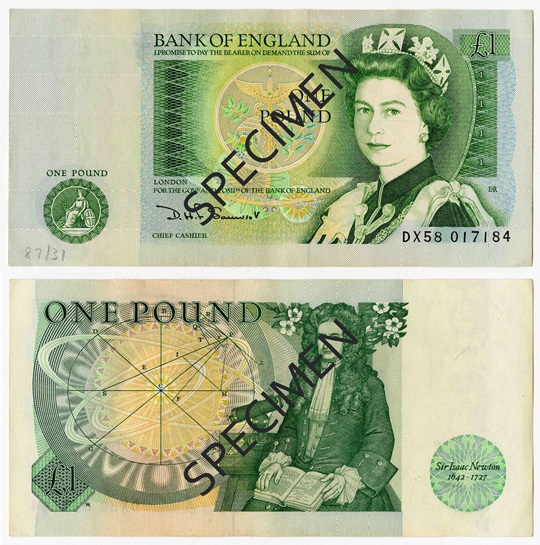
Front and back of note
£1 Series D (pictorial series)
Date first issued: 9 February 1978
Date ceased to be legal tender: 11 March 1988
Colour: Predominantly green
Size: 5 5/16" x 2 5/8" (135mm x 67mm)
Design: Harry Eccleston. Sir Isaac Newton portrayed on reverse. A particular feature of this note was that it had only one serial number.
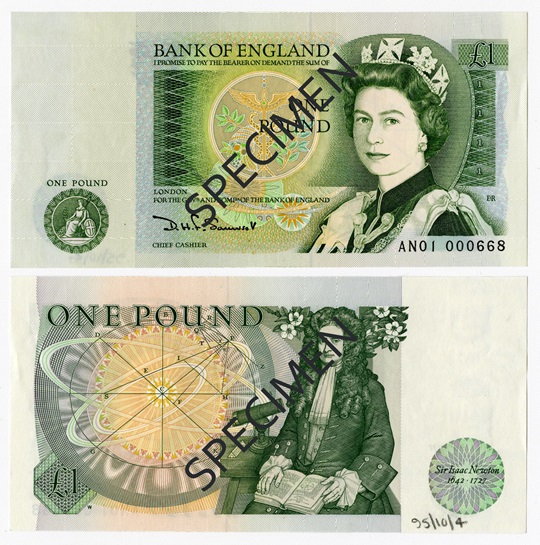
Front and back of note
£10 Series D (pictorial series)
Date first issued: 20 February 1975
Date ceased to be legal tender: 20 May 1994
Colour: Predominantly brown
Size: 5 7/8" x 3 5/16" (151mm x 85mm)
Design: Harry Eccleston. Florence Nightingale portrayed on reverse. New 'windowed' security thread introduced on 16 July 1987.
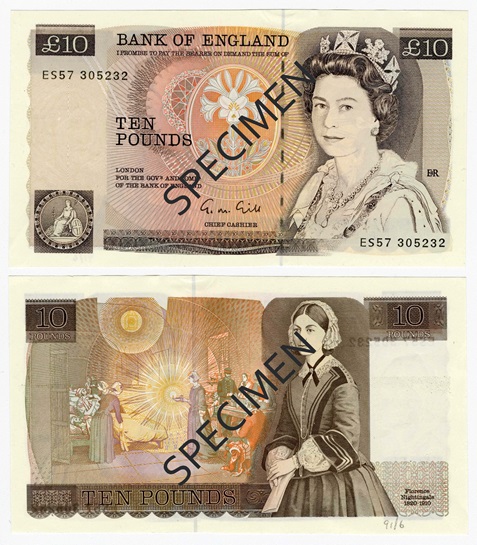
Front and back of note
£5 Series D (pictorial series)
Date first issued: 11 November 1971
Date ceased to be legal tender: 29 November 1991
Colour: Predominantly blue
Size: 5 3/4" x 3 1/16" (145mm x 78mm)
Design: Harry Eccleston. Duke of Wellington portrayed on reverse; width of thread doubled to 1mm from 16 July 1987.
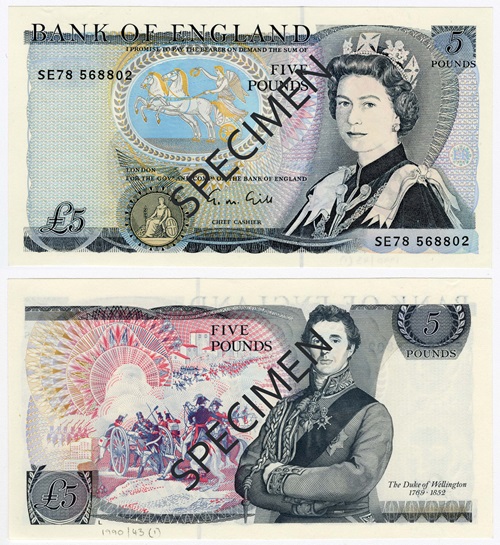
Front and back of note
£20 Series D (pictorial series)
Date first issued: 9 July 1970
Date ceased to be legal tender: 19 March 1993
Colour: Predominantly purple
Size: 6 5/16" x 3 9/16" (160mm x 90mm)
Design: Harry Eccleston. William Shakespeare portrayed on the reverse. First £20 note to carry portrait of monarch and to use threaded paper. New 'windowed' security thread introduced on 15 November 1984.
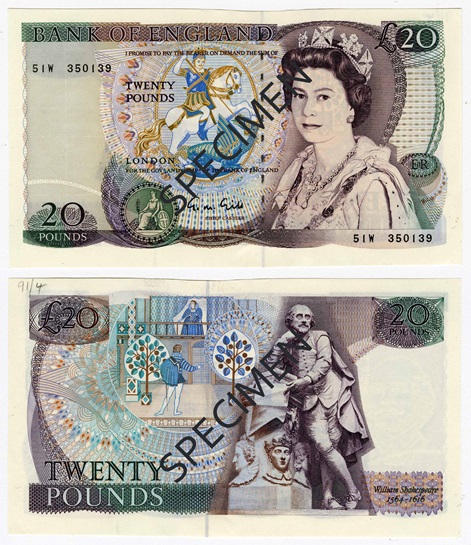
Front and back of note
£10 Series C (portrait series)
Date first issued: 21 February 1964
Date ceased to be legal tender: 31 May 1979
Colour: Brown
Size: 5 7/8" x 3 5/8" (150mm x 93mm)
Design: Reynolds Stone. First £10 note to carry portrait of monarch and to use threaded paper
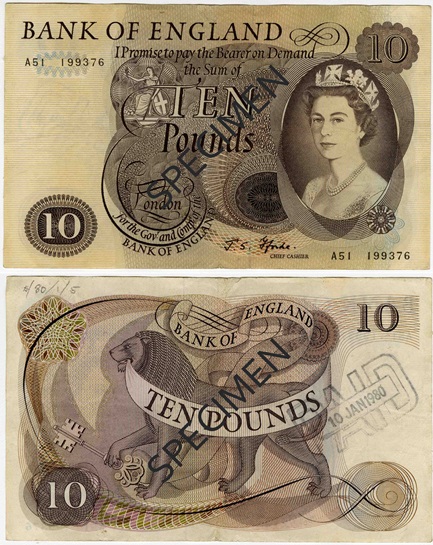
Front and back of note
£5 Series C (portrait series)
Date first issued: 21 February 1963
Date ceased to be legal tender: 31 August 1973
Colour: Blue
Size: 5 1/2" x 3 5/16" (140mm x 85mm)
Design: Reynolds Stone. First £5 note to carry portrait of monarch.
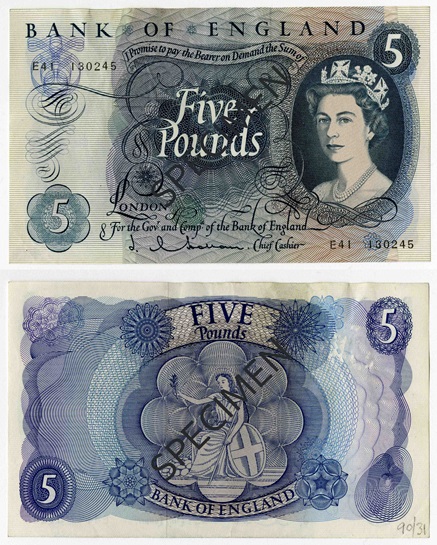
Front and back of note
10 Shilling Series C
Date first issued: 12 October 1961
Date ceased to be legal tender: 22 November 1970
Colour: Red-brown
Size: 5 ½" x 2 5/8" (140mm x 67mm)
Design: Robert Austin. First and only issued Bank of England 10 Shilling note to carry portrait of monarch.
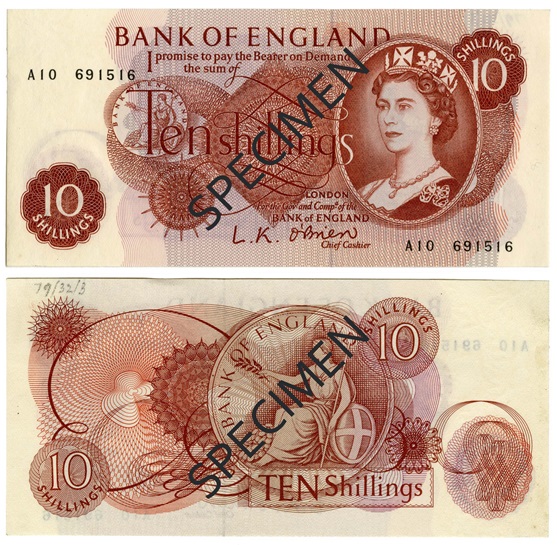
Front and back of note
£1 Series C
Date first issued: 17 March 1960
Date ceased to be legal tender: 31 May 1979
Colour: Green
Size: 6" x 2 13/16" (151mm x 72mm)
Design: Robert Austin. First Bank of England £1 note to carry portrait of monarch.
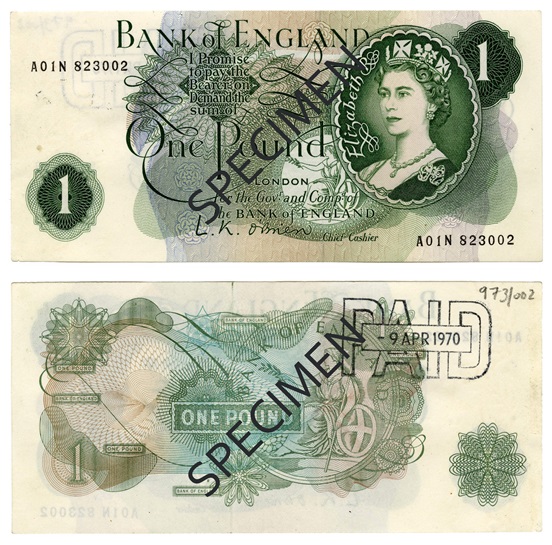
Front and back of note
£5 Series B
Date first issued: 21 February 1957
Date ceased to be legal tender: 27 June 1967
Colour: Blue
Size: 6 1/4" x 3 1/2" (158mm x 90mm)
Design: Stephen Gooden. Features helmeted Britannia on front.
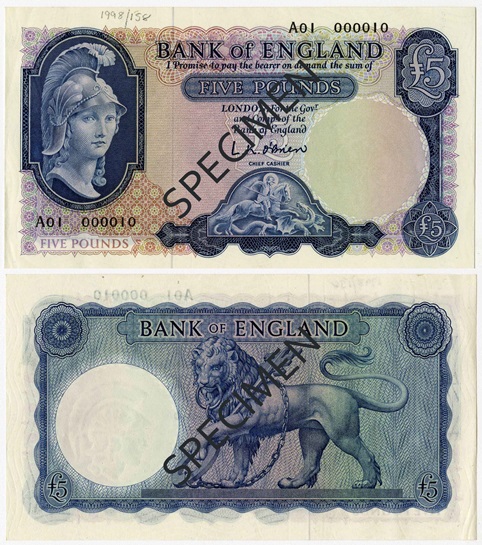
Front and back of note
10 Shilling Series A (3rd issue)
Date first issued: 25 October 1948
Date ceased to be legal tender: 29 October 1962
Colour: Brown
Size: 5 7/16" x 3 1/16" (138mm x 78mm)
Design: Issue of threaded notes in pre-war colour.
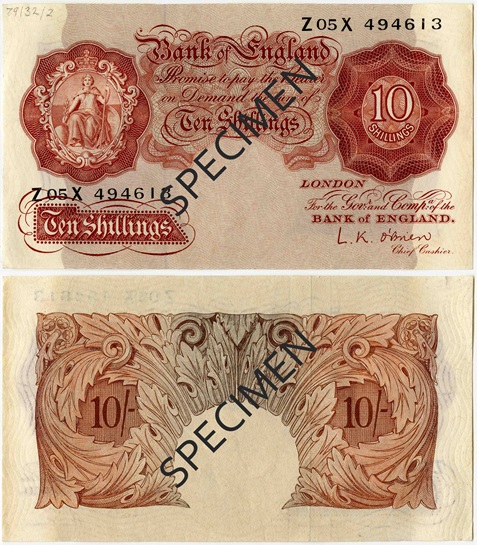
Front and back of note
£1 Series A (3rd issue)
Date first issued: 13 September 1948
Date ceased to be legal tender: 28 May 1962
Colour: Green.
Size: 5 15/16" x 3 5/16" (151mm x 84mm)
Design: W M Keesey and others. Issue of threaded notes in pre-war colour.
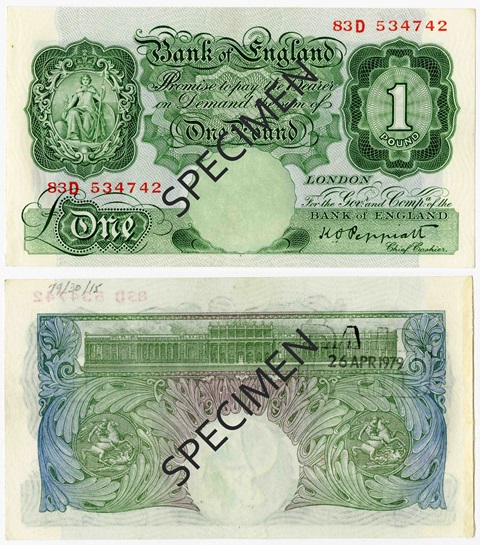
Front and back of note
£1 Series A (2nd issue)
Date first issued: 17 June 1948
Date ceased to be legal tender: 28 May 1962
Colour: Green.
Size: 5 15/16" x 3 5/16" (151mm x 84mm)
Design: W M Keesey and others. Reissue of unthreaded pre-war notes.
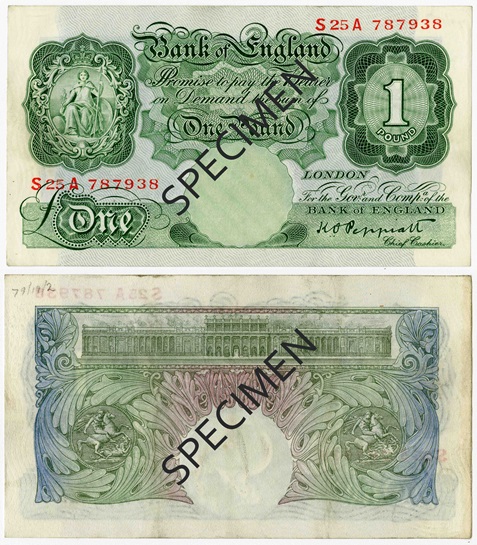
Front and back of note
10 Shilling Series A (2nd issue)
Date first issued: 17 June 1948
Date ceased to be legal tender: 29 October 1962
Colour: Brown.
Size: 5 7/16" x 3 1/16" (138mm x 78mm)
Design: Re-issue of unthreaded pre-war notes.
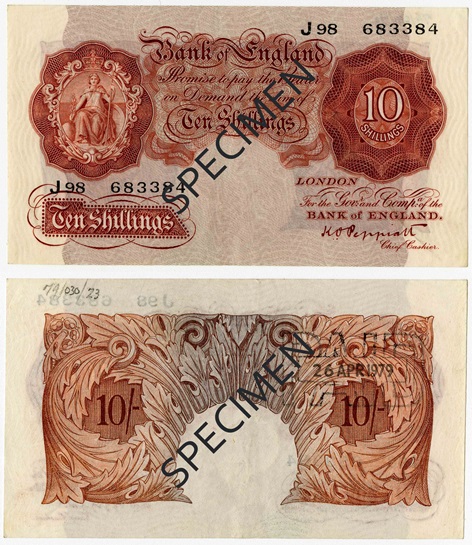
Front and back of note
£5 White
Date first issued: 1945
Date ceased to be legal tender: 13 March 1961
Colour: Monochrome (printed on one side only)
Size: 8 1/4" x 5 1/4" (211mm x 133mm)
Design: Incorporated metal thread for first time: permanent feature thereafter.
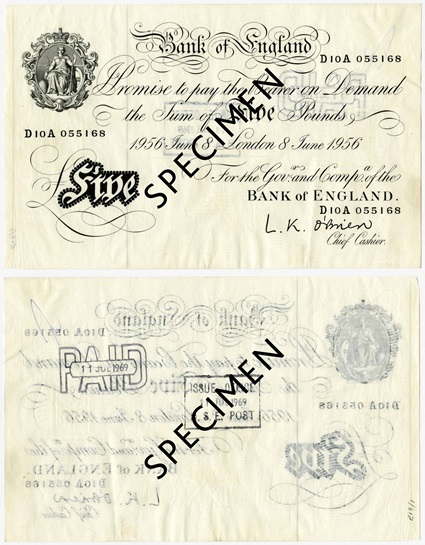
10 Shilling Emergency Wartime Issue
Date first issued: 2 April 1940
Date ceased to be legal tender: 22 October 1962
Colour: Mauve and grey
Size: 5 7/16" x 3 1/16" (138mm x 78mm)
Design: W M Keesey and others. Incorporated metal thread for first time: permanent feature since 1948.
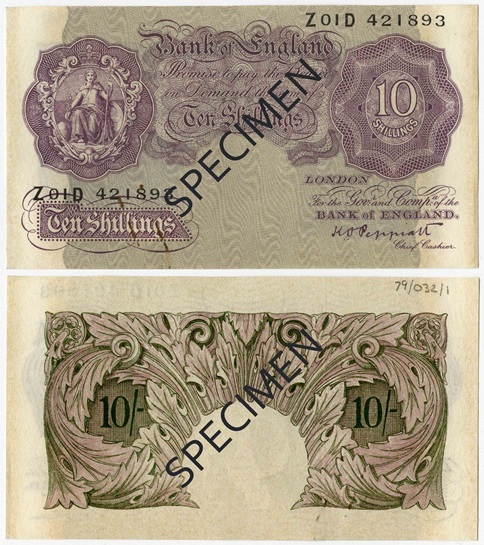
Front and back of note
£1 Emergency Wartime Issue
Date first issued: 29 March 1940
Date ceased to be legal tender: 28 May 1962
Colour: Pale blue and orange
Size: 5 15/16" x 3 15/16" (151mm x 85mm)
Design: W M Keesey and others. Incorporated metal thread for first time: permanent feature since 1948.

Front and back of note
£1 Series A (1st issue)
Date first issued: 22 November 1928
Date ceased to be legal tender: 28 May 1962
Colour: Green
Size: 5 15/16" x 3 5/16" (151mm x 84mm)
Design: W M Keesey and others.
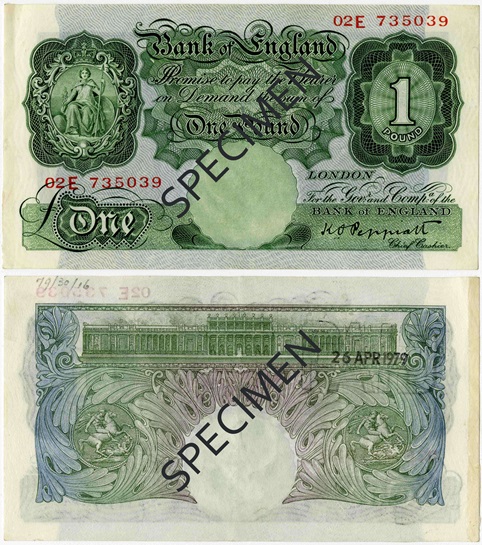
Front and back of note
10 Shilling Series A (1st issue)
Date first issued: 22 November 1928
Date ceased to be legal tender: 29 October 1962
Colour: Red-brown
Size: 5 7/16" x 3 1/16" (138mm x 78mm)
Design: W M Keesey and others.
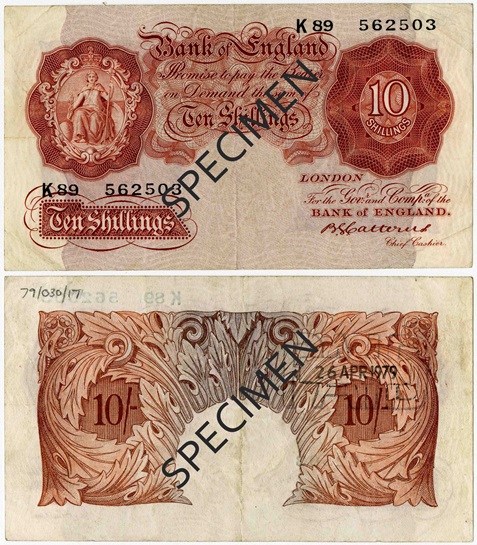
Front and back of note
10 Shilling 3rd Series Treasury Issue
Date first issued: 22 October 1918
Date ceased to be legal tender: 1 August 1933
Colour: Green and brown.
Size: 5 7/16" x 3 1/16" (138mm x 78mm)
Design: Bertram Mackennal. Printed by Waterlow Bros and Layton on banknote paper. Signature of N.F. Warren Fisher from September 1919. In 1922, wording at the top changed to ‘United Kingdom of Great Britain and Northern Ireland’.
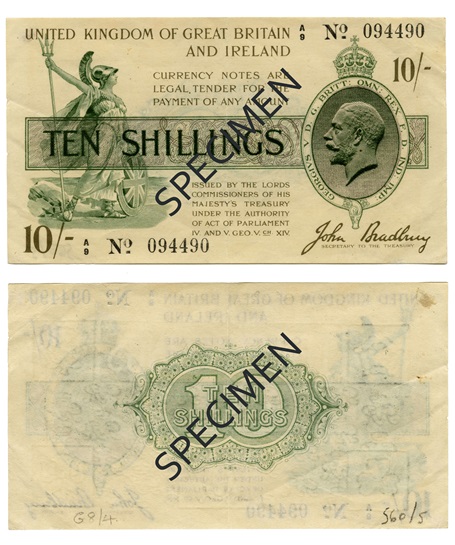
Front and back of note
£1 3rd Series Treasury Issue
Date first issued: 22 January 1917
Date ceased to be legal tender: 1 August 1933
Colour: Brown and green.
Size: 5 15/16" x 3 5/16" (151mm x 84mm)
Design: Bertram Mackennal. Printed by Waterlow Bros and Layton on banknote paper. Signature of N.F. Warren Fisher from September 1919. In 1922, wording at the top changed to ‘United Kingdom of Great Britain and Northern Ireland’.
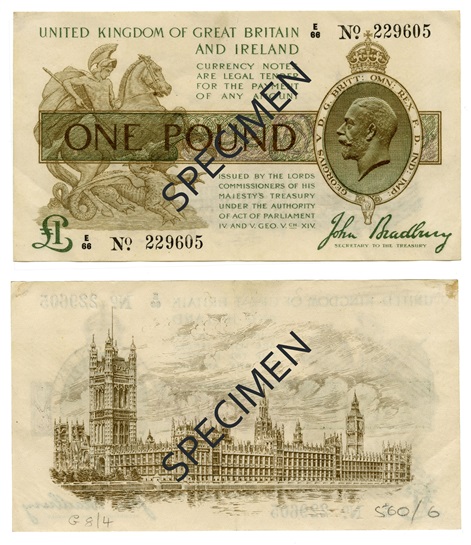
Front and back of note
10 shilling 2nd Series Treasury Issue
Date first issued: 21 January 1915
Date ceased to be legal tender: 12 June 1920
Colour: Red on white (printed on one side only)
Size: 5 3/8" x 3" (136mm x 76mm)
Design: George Eve. Printed by De La Rue & Co on banknote paper.
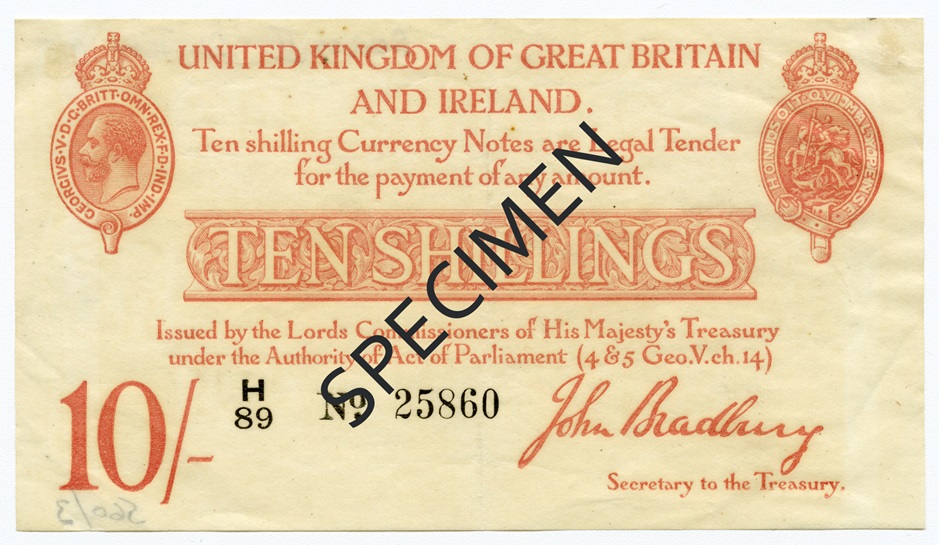
Front of note
£1 2nd Series Treasury Issue
Date first issued: 23 October 1914
Date ceased to be legal tender: 12 June 1920
Colour: Black on white (printed on one side only)
Size: 5 7/8" x 3 ¼" (149mm x 83mm)
Design: George Eve. Printed by De La Rue & Co on banknote paper.
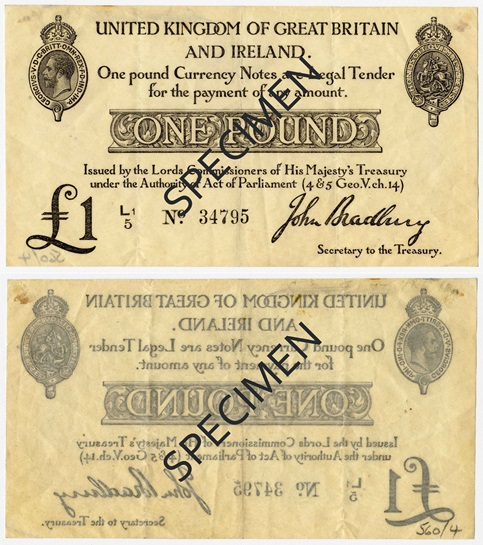
Front and back of note
10 Shilling 1st Series Treasury issue
Date first issued: 14 August 1914
Date ceased to be legal tender: 12 June 1920
Colour: Red on white (printed on one side only)
Size: 5" x 2 ½" (127mm x 64mm)
Design: Designed at Royal Mint from sketches by Frederick Atterbury. Printed by Waterlow Bros. and Layton and De La Rue & Co. Printed on postage stamp paper.
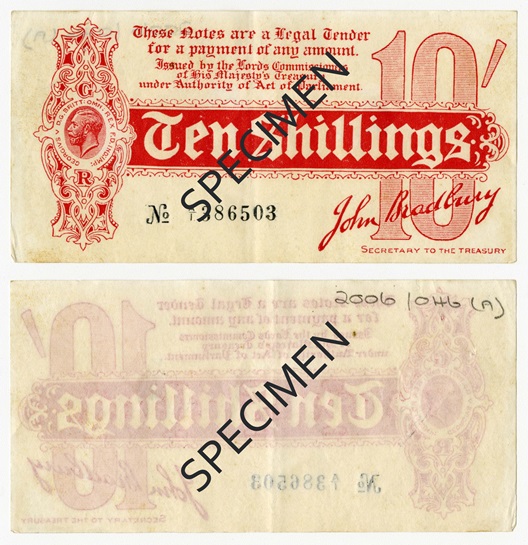
Front and back of note
£1 1st Series Treasury Issue
Date first issued: 7 August 1914
Date ceased to be legal tender: 12 June 1920
Colour: Black on white (printed on one side only)
Size: 5" x 2 1/2" (127mm x 64mm)
Design: Designed at Royal Mint from sketches by Frederick Atterbury. Printed by Waterlow Bros. and Layton from plates by Eyre and Spottiswoode. Printed on postage stamp paper. Nicknamed "Bradburys" on account of signature of Sir John Bradbury, Permanent Secretary to the Treasury.
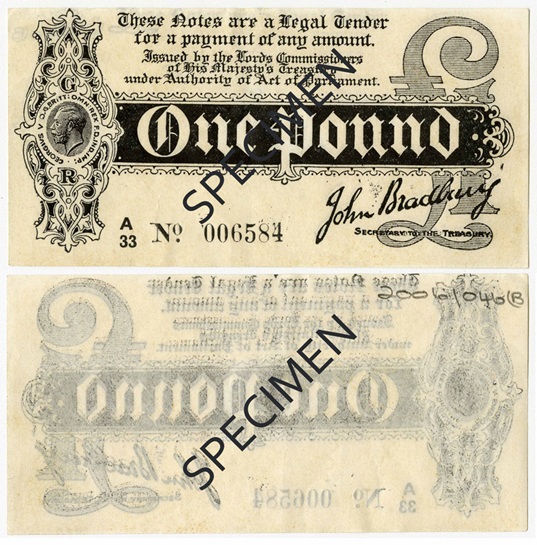
Front and back of note
£1
Date first issued: 2 March 1797
Date last issued: 1821/1825-6
Date ceased to be legal tender: unknown
Colour: Monochrome (printed on one side only).
Size: Vary Approximately 7 7/8" x 4 7/16" (200mm x 113mm)
Design: Several changes of design between 1779 and 1821. Also issued during financial crisis of 1825-6. Nicknamed "Newlands" after name of Chief Cashier, Abraham Newland (1778-1807) in payee clause.
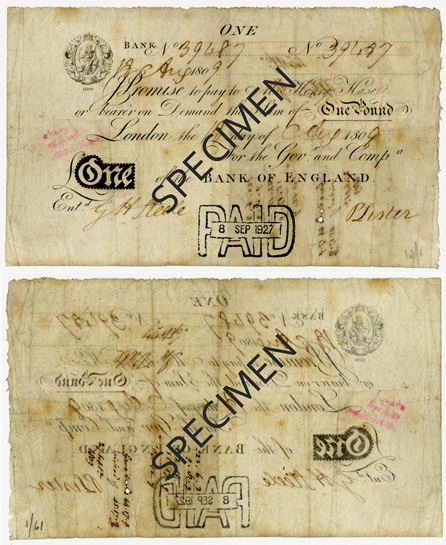
£2
Date first issued: 2 March 1797
Date ceased to be legal tender: unknown
Colour: Monochrome (printed on one side only)
Size: Sizes vary 7 7/8" x 4 7/16" (200mm x 113mm)
Design: Several changes of design between 1797 and 1821.
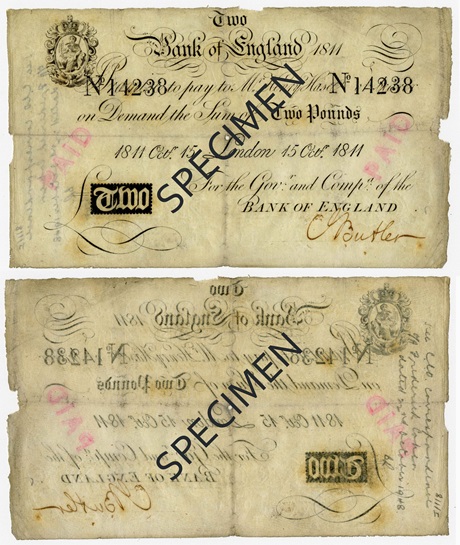
Front and back of note
£5 White
Date first issued: 1793
Date ceased to be legal tender: 1 March 1946
Colour: Monochrome (printed on one side only)
Size: 7 11/16" x 4 11/16" (195mm x 120mm)
Design: Size may vary. Issued also by Bank of England Country Branches from 1826.
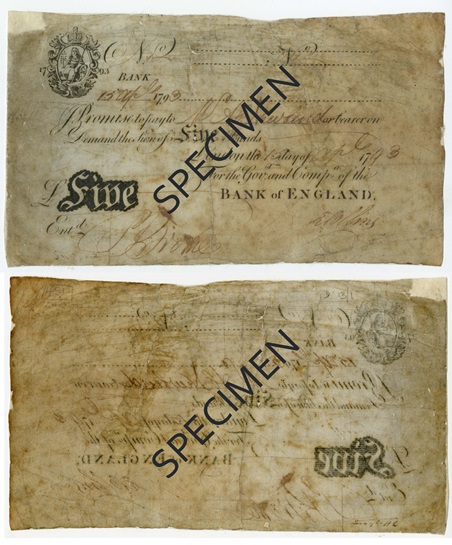
Front and back of note
£25 White
Date first issued: 1765
Date ceased to be legal tender: unknown
Colour: Monochrome (printed on one side only)
Size: Approx 8" x 5" (203mm x 127mm)
Design: unknown
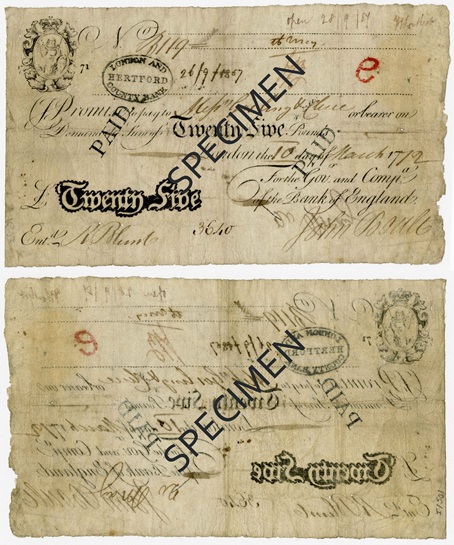
Front and back of note
£10 White
Date first issued: 1759
Date ceased to be legal tender: 16 April 1945
Colour: Monochrome (printed on one side only)
Size: 8 1/4" x 5 1/4" (211mm x 133mm)
Design: Notes in earlier years are slightly smaller. Issued also by Bank of England Country Branches from 1826.
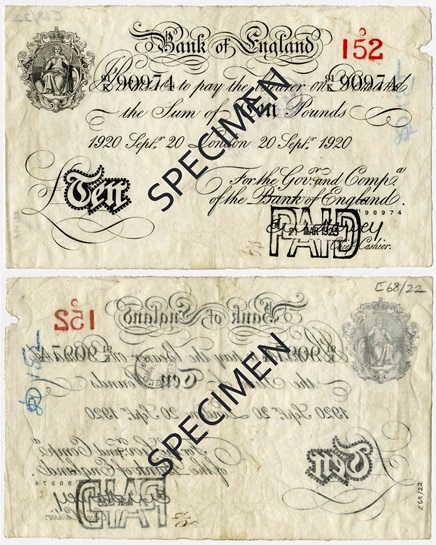
Front and back of note
£15 White
Date first issued: 1759
Date ceased to be legal tender: unknown
Colour: Monochrome (printed on one side only)
Size: Approx 8" x 5" (203mm x 127mm)
Design: Early notes are slightly smaller.
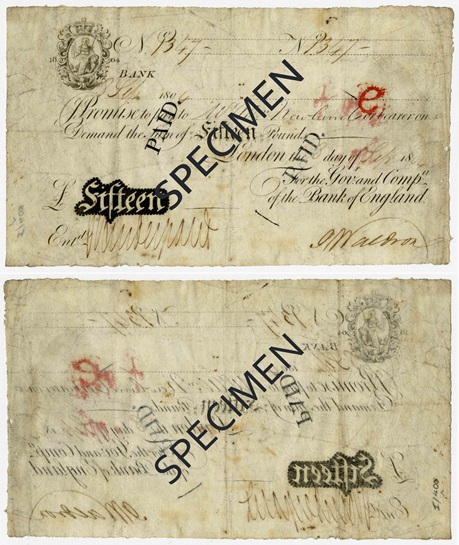
Front and back of note
£20 White
Date first issued: 1725
Date ceased to be legal tender: 16 April 1945
Colour: Monochrome (printed on one side only)
Size: 8 1/4" x 5 1/4" (211mm x 133mm)
Design: Notes in earlier years are slightly smaller. Issued also by Bank of England Country Branches from 1826.
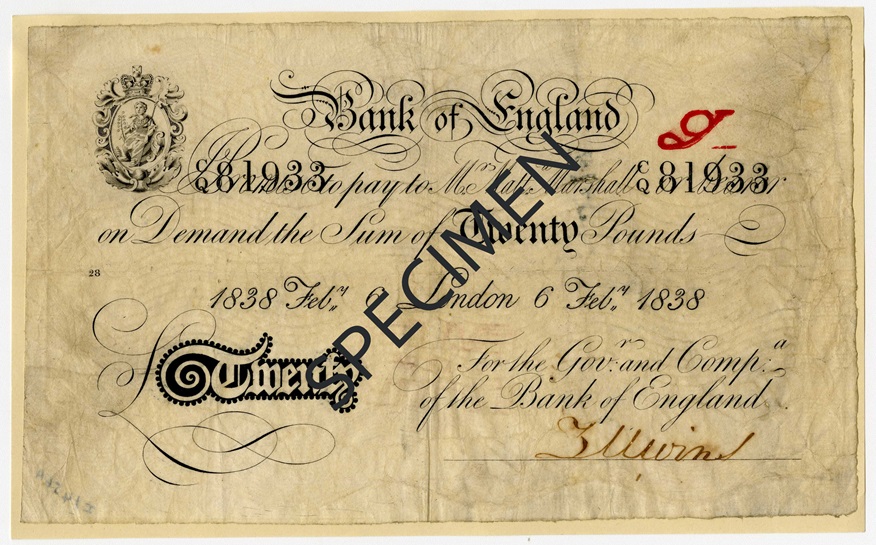
Front of note
£30 White
Date first issued: 1725
Date ceased to be legal tender: unknown
Colour: Monochrome (printed on one side only)
Size: Approx 8 1/4" x 5 1/8" (211mm x 130mm)
Design: Early notes are slightly smaller. Issued also by some Bank of England Country Branches.
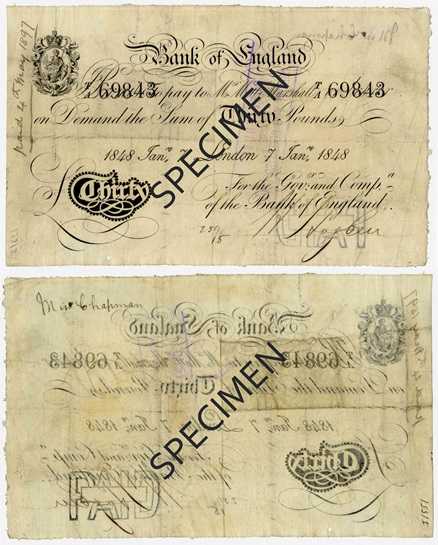
Front and back of note
£40 White
Date first issued: 1725
Date ceased to be legal tender: unknown
Colour: Monochrome (printed on one side only)
Size: Approx 8 1/4" x 5 1/8" (211mm x 130mm)
Design: Early notes are slightly smaller. Issued also by some Bank of England Country Branches.
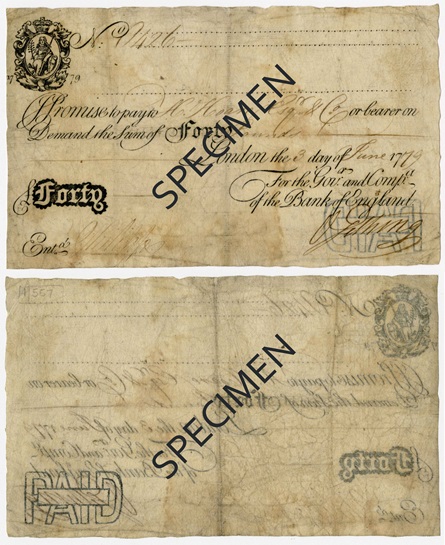
Front and back of note
£50 White
Date first issued: 1725
Date ceased to be legal tender: 16 April 1945
Colour: Monochrome (printed on one side only)
Size: Approx 8 1/4" x 5 1/4" (211mm x 133mm)
Design: Notes in earlier years are slightly smaller. Issued also by Bank of England Country Branches from 1826.
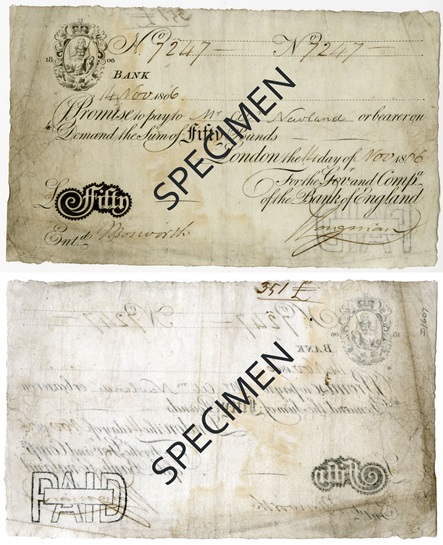
Front and back of note
£100 White
Date first issued: 1725
Date ceased to be legal tender: 16 April 1945
Colour: Monochrome (printed on one side only)
Size: Approx 8 1/4" x 5 1/4" (211mm x 133mm)
Design: Issued also by Bank of England Country Branches from 1826.
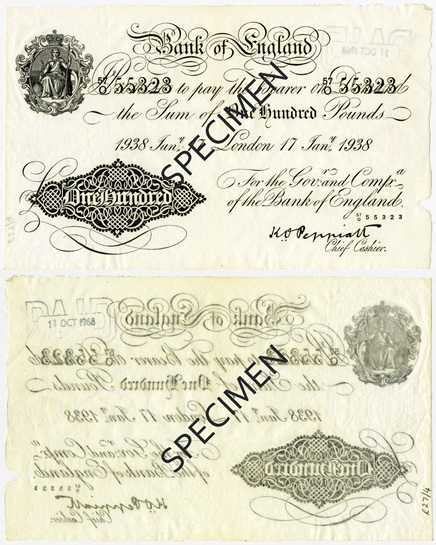
Front and back of note
£60 White
Date first issued: Between 1725 and 1740
Date ceased to be legal tender: unknown
Colour: Monochrome (printed on one side only)
Size: Approx 7 11/16" x 4 11/16" (195mm x 120mm)
Design: Notes in earlier years are slightly smaller.
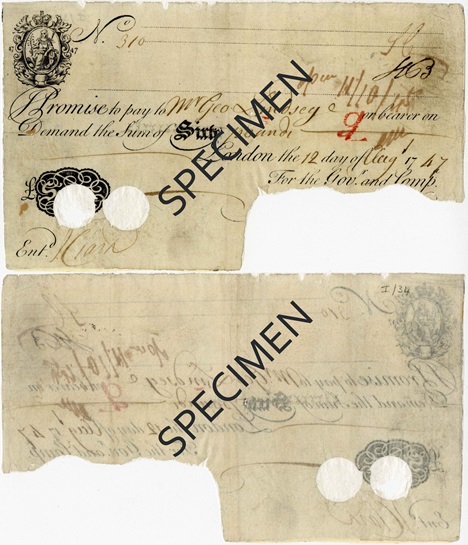
Front and back of note
£70 White
Date first issued: Between 1725 and 1745
Date ceased to be legal tender: unknown
Colour: Monochrome (printed on one side only)
Size: Approx 7 11/16" x 4 11/16" (195mm x 120mm)
Design: Notes in earlier years are slightly smaller.
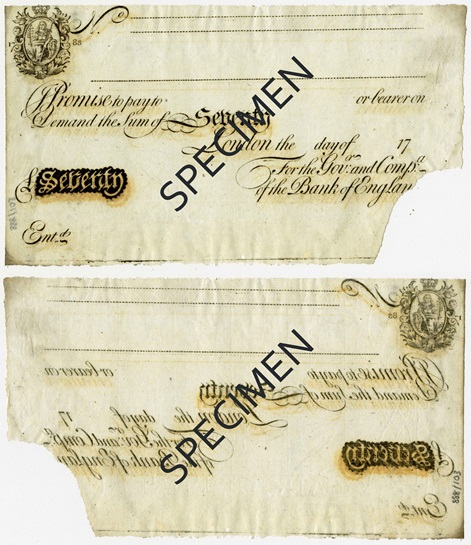
Front and back of note
£80 White
Date first issued: Between 1725 and 1745
Date ceased to be legal tender: unknown
Colour: Monochrome (printed on one side only)
Size: Approx 7 11/16" x 4 11/16" (195mm x 120mm)
Design: Notes in earlier years are slightly smaller.
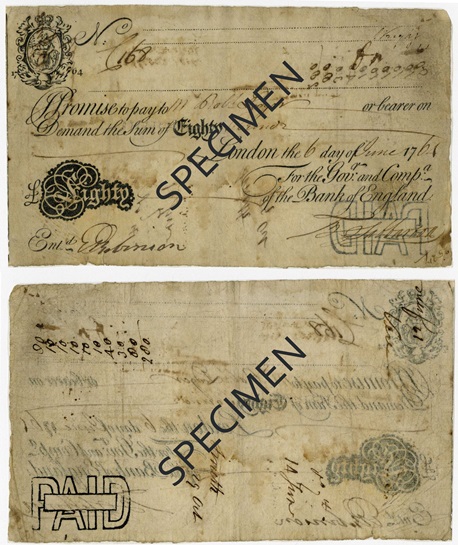
Front and back of note
£90 White
Date first issued: Between 1725 and 1745
Date ceased to be legal tender: unknown
Colour: Monochrome (printed on one side only)
Size: Approx 7 11/16" x 4 11/16" (195mm x 120mm)
Design: Notes in earlier years are slightly smaller.
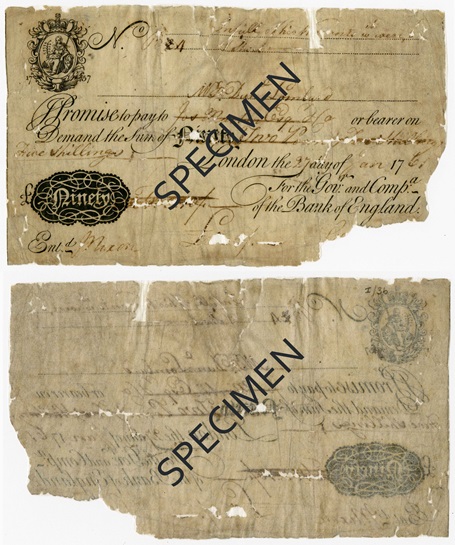
Front and back of note
£200 White
Date first issued: Between 1725 and 1745
Date ceased to be legal tender: 16 April 1945
Colour: Monochrome (printed on one side only)
Size: Approx 8 1/4" x 5 1/4" (211mm x 133mm)
Design: Notes in earlier years are slightly smaller. £200 notes not issued by Bank of England Country Branches.
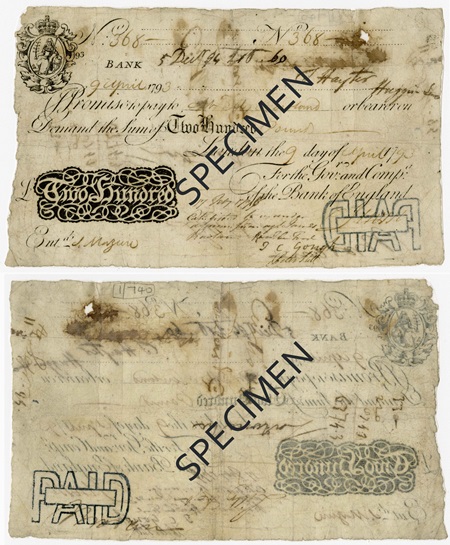
Front and back of note
£300 White
Date first issued: Between 1725 and 1745
Date ceased to be legal tender: unknown
Colour: Monochrome (printed on one side only)
Size: Approx 8 1/4" x 5 1/8" (211mm x 130mm)
Design: £300 notes not issued by Bank of England Country Branches.
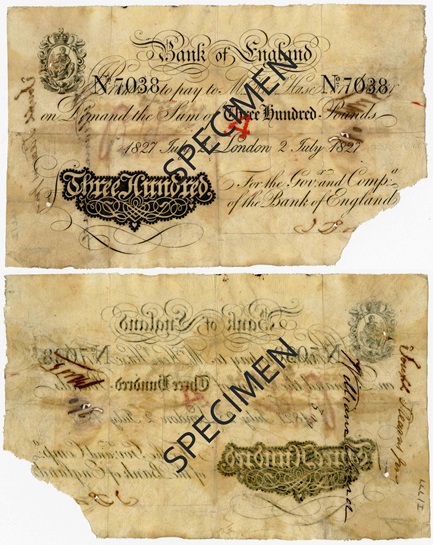
Front and back of note
£500 White
Date first issued: Between 1725 and 1745
Date ceased to be legal tender: 16 April 1945
Colour: Monochrome (printed on one side only)
Size: Approx 8 1/4" x 5 1/4" (211mm x 133mm)
Design: Notes in earlier years are slightly smaller. £500 notes issued by some Bank of England Country Branches from 1826.
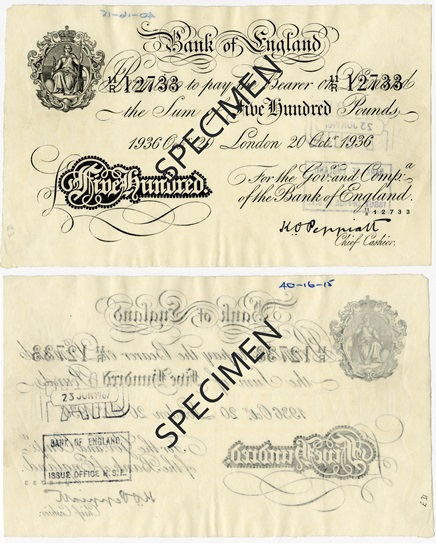
Front and back of note
£1000 White
Date first issued: Between 1725 and 1745
Date ceased to be legal tender: 16 April 1945
Colour: Monochrome (printed on one side only)
Size: Approx 8 1/4" x 5 1/4" (211mm x 133mm)
Design: Notes in earlier years are slightly smaller. £1,000 notes not issued by Bank of England Country Branches except Hull between 1882 and 1889.
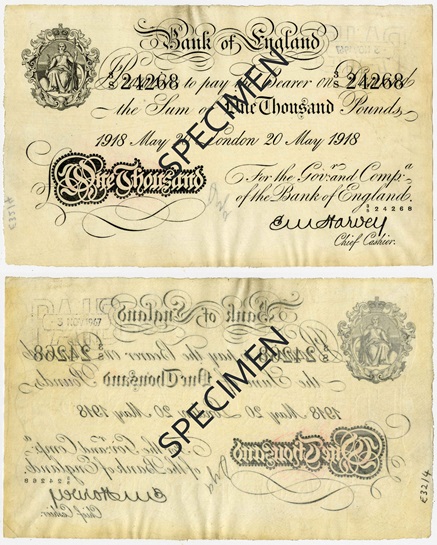
Front and back of note
